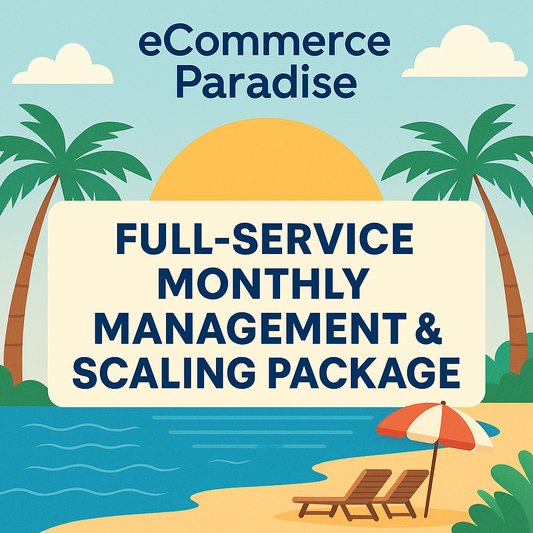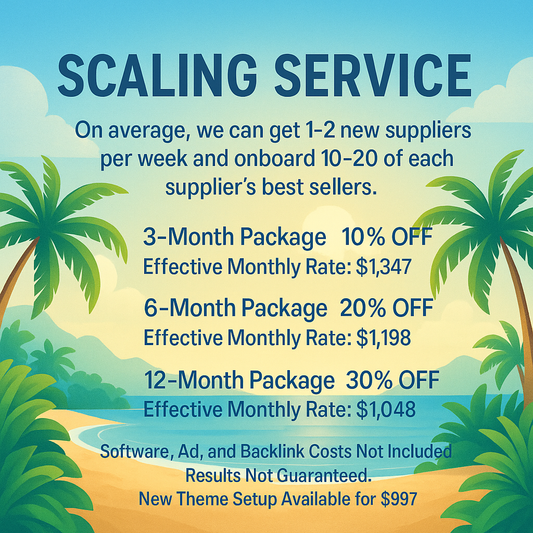
Unlocking SEO: On-Page vs. Off-Page Simplified
Hey there, fellow eCommerce enthusiasts! Trevor Fenner here from eCommerce Paradise, and today we're diving deep into one of the most essential topics in the world of digital marketing: the difference between on-page and off-page SEO. Whether you’re running a dropshipping business or trying to fine-tune your Google Shopping Ads, understanding these two SEO strategies can transform your eCommerce store from ordinary to extraordinary. Let’s get started!
What is SEO, Anyway?
Before we can dive into on-page and off-page SEO, let’s establish a solid foundation by discussing what SEO actually is. SEO, or Search Engine Optimization, refers to the techniques and strategies used to improve a website’s visibility on search engines like Google. The better your SEO practices, the more traffic you’ll attract to your store, which ultimately boosts your sales. Now, let’s break down the two key components of SEO: on-page and off-page.
On-Page SEO Explained
On-page SEO involves optimizing elements within your own website to help search engines understand your content better. This is crucial for eCommerce SEO, where properly structured content can lead to higher rankings in search results. Key activities that fall under on-page SEO include:
1. Keyword Research
Researching keywords relevant to your niche is the first step in optimizing your pages. Tools like Google Keyword Planner or Ubersuggest can help you find the right terms your audience is searching for. Incorporate these keywords naturally into your product descriptions, meta titles, and alternative text for images.
2. Title Tags and Meta Descriptions
Your title tag and meta description are like your digital storefront—make sure they are catchy and include relevant keywords. These tags appear in search results, so it’s essential to sum up what your page is about and entice users to click through.
3. Quality Content
Creating valuable, informative content not only improves user experience but also boosts your SEO. Write detailed product descriptions that address common customer questions and showcase unique selling points. If you're dropshipping, detail how your products stand out in a saturated market!
4. Image Optimization
Don't underestimate the power of visuals! Use high-quality images and optimize their file names and alt text for better SEO performance. This not only helps with search engine indexing but improves accessibility for all users.
5. Internal Linking
Linking to other relevant content within your site ensures users have an easy navigation experience and encourages them to spend more time browsing. This can lead to higher conversion rates and improved SEO rankings.
Off-Page SEO Unveiled
If on-page SEO focuses on elements within your site, off-page SEO is all about building a brand’s reputation and authority through external means. Off-page SEO can enhance your site's visibility and credibility, leading to improved rankings. Let’s explore some crucial aspects:
1. Backlinks
Backlinks are links from other websites directing traffic to yours, and they are vital for improving your overall authority in search engines. Quality over quantity is key here; a few backlinks from reputable sites are far more valuable than numerous links from low-quality websites.
2. Social Media Engagement
Active social media channels can significantly boost your off-page SEO. By sharing content, engaging with your audience, and promoting your products, you can drive organic traffic back to your store. Don’t forget to leverage email marketing as well! Sending customer newsletters showcasing your products can drive significant traffic and foster a dedicated customer base.
3. Brand Mentions
Even if you aren’t directly mentioned with a hyperlink, brand mentions can still enhance your off-page SEO. Aim for positive exposure in blogs, forums, and other online communities. Engaging in conversations within these spaces can help establish your authority and drive brand awareness.
4. Influencer Marketing
Collaborating with influencers can offer a significant boost to your off-page SEO. When a reputable influencer talks about your brand or lore of your dropshipping products, it not only increases your visibility but can lead to new customers. Choose influencers that resonate with your target audience for maximum impact!
On-Page and Off-Page SEO: A Perfect Pairing
While both on-page and off-page SEO play distinct roles in your website's performance, they truly shine when they work together. Imagine having well-optimized content (on-page) being actively promoted through social media and garnering backlinks (off-page). The synergy between these factors can create a solid foundation for long-term success in eCommerce. Here are some key takeaways:
- Invest time in both on-page and off-page SEO strategies.
- Keep an eye on your website's analytics to gauge the effectiveness of your efforts.
- Stay updated with industry trends as algorithms and SEO strategies continue to evolve.
The Role of Google Shopping Ads in SEO
When discussing SEO, we can’t overlook Google Shopping Ads. While they are a form of paid advertising rather than SEO, integrating them can be beneficial for your eCommerce venture. By optimizing your product feeds and ensuring high-quality images and content, you can leverage Google Shopping Ads to drive targeted traffic to your store. Remember, even a well-executed SEO strategy is often complemented by paid efforts, creating a balanced marketing approach.
Final Thoughts: Your SEO Journey Awaits!
Understanding the differences between on-page and off-page SEO is vital in shaping your eCommerce success story. By leveraging both strategies effectively, you can optimize your store for visibility, ease-of-use, and customer engagement. Remember that patience and consistency are key; SEO is a marathon, not a sprint. Keep learning, adapting, and implementing new strategies, and you’ll see your online store flourish. At eCommerce Paradise, we’re excited to help you along this journey. Keep pushing those boundaries and thriving in the world of dropshipping!


















